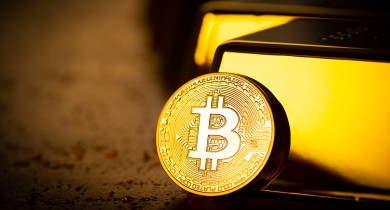
Bitcoin’s Correlation to Gold Tightened in March Amid TradFi Woes
In March, the correlation between Bitcoin and gold experienced a notable tightening, particularly against the backdrop of challenges faced by traditional finance (TradFi). Bitcoin, often touted as digital gold, has long been considered a store of value and a hedge against economic uncertainties, much like its physical counterpart, gold.
Traditionally, gold has been a preferred safe-haven asset during times of financial turmoil. However, in recent years, Bitcoin has emerged as a digital alternative, gaining recognition for its decentralized nature and potential to act as a hedge against inflation. The tightening correlation observed in March suggests that investors are increasingly viewing Bitcoin through a similar lens as gold, seeking refuge in the digital asset amid concerns within traditional financial markets.
Several factors contributed to this correlation tightening. Economic uncertainties, global geopolitical tensions, and inflationary fears prompted investors to diversify their portfolios, with both Bitcoin and gold serving as alternative assets. Additionally, the decentralized nature of cryptocurrencies appealed to those seeking financial instruments less susceptible to the challenges faced by traditional financial systems.
The month's events underscore the evolving narrative around Bitcoin, with its price movements increasingly reflecting its role as a macroeconomic indicator. As Bitcoin continues to mature as an asset class, its correlation to traditional safe-haven assets like gold is likely to be closely monitored by both crypto enthusiasts and mainstream investors alike.
The tightening correlation between Bitcoin and gold during March also reflects a broader trend in which digital assets are becoming integral components of diversified investment portfolios. Institutional investors, in particular, are increasingly recognizing the potential of cryptocurrencies as a legitimate asset class. As they seek ways to mitigate risks and enhance returns, the correlation between Bitcoin and gold becomes a crucial metric for assessing the overall resilience of a diversified investment strategy.
The performance of Bitcoin during periods of traditional financial market distress adds credence to its narrative as "digital gold." While gold has historically been the go-to safe-haven asset, Bitcoin's ability to maintain or increase in value during economic uncertainties positions it as a modern alternative. The month of March, marked by financial market turbulence, served as a litmus test for Bitcoin's capacity to withstand and even thrive amid adverse conditions, further solidifying its status as a store of value.
It's important to note that the relationship between Bitcoin and gold is dynamic, influenced by various market factors. While both assets may exhibit correlations during times of crisis, their individual characteristics also set them apart. Bitcoin's unique attributes, such as its limited supply and decentralized nature, contribute to its appeal beyond traditional financial safe havens. n summary, the tightened correlation between Bitcoin and gold in March highlights the growing recognition of Bitcoin as a digital store of value and a hedge against economic uncertainties, underlining its evolving role in the broader financial landscape.




